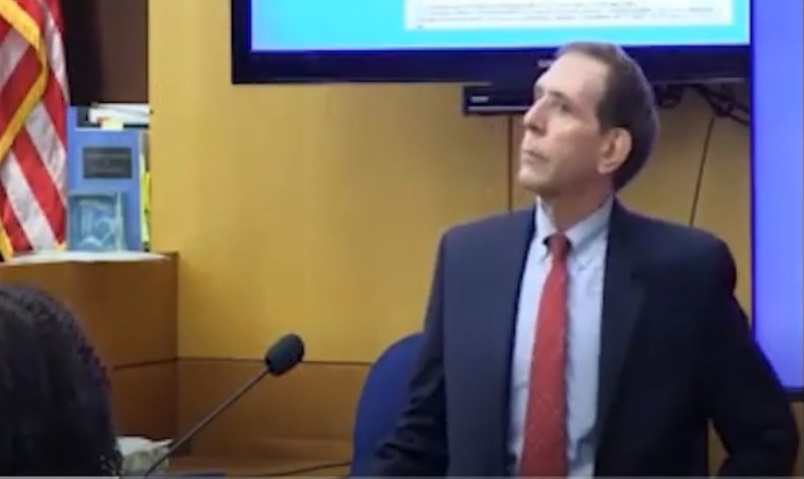

The Expert: Dr. Ralph Terpolilli, a Houston, Texas-based expert in emergency medicine, walks jurors the defendant physician’s treatment of the patient.

Testifying for the plaintiff in a 2016 medical malpractice trial, Dr. Ralph Terpolilli, a Houston-based expert in emergency medicine, reviews the defendant physicians’ treatment for the jury.
When the patient first presented to the ER, she complained of severe shortness of breath and felt like her throat was closing. She was on medication that could cause angioneurotic edema, a generalized swelling of the face, tongue, larynx, abdomen, and extremities, which occurs within minutes or hours of the administration of the medication. The ER doctor’s findings confirmed the presence of stridor when the patient attempted to breathe, as well as swelling of the pharynx and uvula (structures in the back of the throat) which was hindering her ability to pull air down into her lungs. The ER personnel prepared for a “rapid sequence induction” during which this patient would be paralyzed to allow for quick endotracheal intubation as her ability to breathe and respond to manipulation was blocked pharmaceutically to “relax” her.
Although she was “preoxygentated” with 100% oxygen by mask in preparation for the rapid sequence endotracheal intubation, Terpolilli explains his belief that the decision to employ rapid sequence intubation was “grossly negligent,” given the difficulties identifying the structures in the back of the throat, the stability of the patient, and the ready availability of anesthetists and anesthesiologists in house to perform or assist with a difficult intubation. Once it was noted that the normal landmarks for intubation were obliterated by swelling, the ER physician caring for the patient put aside his regular laryngoscope and attempted visualization with a video laryngoscope. However, he could not see any better. He asked for help from the respiratory therapists who declined to try, so he requested that another ER physician assist him. That physician was in the middle of a procedure, delaying his attempt at this.
Once the second ER doctor examined the patient, he could not see landmarks either, but noted bubbles coming from the back of the throat. Pushing the tube into where the bubbles were coming from, this doctor hoped that the bubbles were coming from the lungs and not the stomach. Once placed, there were conflicting reports of whether the measured end CO2 level was indicative of placement in the trachea or not. A physical exam could not conclude decisively about this placement either, since air seemed to be moving in the lungs as well as over the stomach. Nonetheless, even though there was no radiologic or definitely confirmatory evidence of proper placement, both doctors left the room for several minutes. The expert sees this as negligent behavior as well.
The patient began to deteriorate as her oxygenation and vital signs fell, due to the improperly placed endotracheal tube. The second treating ER physician returned and blindly placed a second tube above the initially placed tube, leaving the first tube in place. Although proper air flow was confirmed with this second tube, the patient had not been properly oxygenated for almost 16 minutes. The expert reminds us that it only takes 3 minutes at 70% oxygenation for brain damage to occur under these circumstances, so this patient had suffered significant hypoxia before the second tube was placed.
The expert further states that giving a long-term paralytic agent prior to intubation was “gross negligence” as well. If a shorter-term paralyzing agent had been given, perhaps she might have been allowed to awaken once trouble intubating was encountered, thus buying more time until help could arrive.
Finally he points out that, even after the tube was properly placed and its positioning confirmed by X-ray, adequate oxygenation is somewhat delayed once the oxygen levels deteriorate to undetectable levels as in this case. So, it is “reasonable to conclude” that brain damage was ongoing until the oxygen levels improved, despite the eventual proper positioning of the endotracheal tube.
The expert’s testimony preceded a mid-trial settlement.
Gary Gansar, MD, is residency-trained in general surgery. He served as Chief of Surgery and Staff at Elmwood Medical Center and on the Medical Executive Committee at Touro Infirmary and Mercy Hospital in New Orleans, LA. Dr. Gansar was Board Certified in general surgery while in active practice. He joined AMFS in 2015 as a Physician Medical Director.
The medical expert witness partner for attorneys serious about building a winning case
AMFS is your trusted source for highly-qualified medical expert witnesses. After pioneering the field nearly three decades ago, we’re continuing to redefine medical expert witness services by providing value far beyond a referral alone.
Our Physician Medical Directors know what it takes to build a strong case. Our medical expert witnesses leave no doubt. And our case managers streamline billing and logistics every step of the way, letting you focus on what you do best: constructing your winning case. Explore why AMFS clients expect more from their medical expert witnesses—and get it.
